Make: Electronics (67 page)
Authors: Charles Platt

Fundamentals
Coil schematics and basics
Check the schematic symbols for coils in Figure 5-16. Note that if a coil has an iron core, this is shown with an extra couple of lines (sometimes only one line). If it has a ferrite core, the line is sometimes shown with dashes.
An iron core will add to the inductance of a coil, because it increases the magnetic effect.
A coil in isolation does not generally have any polarity. You can connect it either way around, but the magnetic force will be reversed accordingly (coils that interact with stuff—such as in transformers and solenoids—do have polarity).
Perhaps the most widespread application of coils is in transformers, where alternating current in one coil induces alternating current in another, often sharing the same iron core. If the primary (input) coil has half as many turns as the secondary (output) coil, the voltage will be doubled, at half the current—assuming hypothetically that the transformer is 100% efficient.

Figure 5-16.
Schematic diagrams represent coils. At far right is the older style. The third and fourth symbols indicate that the coil is wound around a solid or powdered magnetic core, respectively.
Background
Joseph Henry
Born in 1797, Joseph Henry was the first to develop and demonstrate powerful electromagnets. He also originated the concept of “self-inductance,” meaning the “electrical inertia” that is a property of a coil of wire.
Henry started out as the son of a day laborer in Albany, New York. He worked in a general store before being apprenticed to a watchmaker, and was interested in becoming an actor. Friends persuaded him to enroll at the Albany Academy, where he turned out to have an aptitude for science. In 1826, he was appointed Professor of Mathematics and Natural Philosophy at the Academy, even though he was not a college graduate and described himself as being “principally self-educated.” Michael Faraday was doing similar work in England, but Henry was unaware of it.
Henry was appointed to Princeton in 1832, where he received $1,000 per year and a free house. When Morse attempted to patent the telegraph, Henry testified that he was already aware of its concept, and indeed had rigged a system on similar principles to signal his wife, at home, when he was working in his laboratory at the Philosophical Hall.
Henry taught chemistry, astronomy, and architecture, in addition to physical science, and because science was not divided into strict specialties as it is now, he investigated phenomena such as phosphorescence, sound, capillary action, and ballistics. In 1846, he headed the newly founded Smithsonian Institution as its secretary.
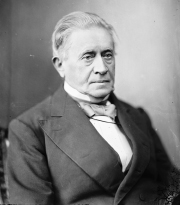
Figure 5-17.
Joseph Henry was an American experimenter who pioneered the investigation of electromagnetism. This photograph is archived in Wikimedia Commons.
Experiment 26: Tabletop Power Generation
If you have just three components, you can see magnetism generating electricity right in front of you, right now.
You will need:
- Cylindrical neodymium magnet, 3/4-inch diameter, axially magnetized. Quantity: 1. (Obtainable online at sites such as
http://www.kjmagnetics.com
.) - Spool of hookup wire, 26-gauge, 100 feet. Quantity: 1.
- Spool of magnet wire, quarter-pound, 26-gauge, about 350 feet. Quantity: 1. (Search online for sources for “magnet wire.”)
- Generic LED. Quantity: 1.
- 100 μF electrolytic capacitor. Quantity: 1.
- Signal diode, 2N4001 or similar. Quantity: 1.
- Jumper wires with alligator clips on the ends. Quantity: 2.
Procedure
You may be able to make this experiment work with the spool of hookup wire, depending on the size of the spool relative to the size of your magnet, but as the results are more likely to be better with the magnet wire, I’ll assume that you’re using that—initially, at least. The advantage of the magnet wire is that its very thin insulation allows the coils to be closely packed, increasing their inductance.
First peek into the hollow center of the spool to see if the inner end of the wire has been left accessible, as is visible in Figures 5-18 and 5-19. If it hasn’t, you have to unwind the wire onto any large-diameter cylindrical object, then rewind it back onto the spool, this time taking care to leave the inner end sticking out.
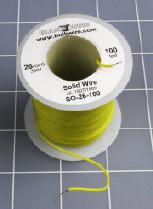
Figure 5-18.
An everyday 100-foot spool of hookup wire is capable of demonstrating the inductive power of a coil.
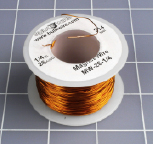
Figure 5-19.
Magnet wire has thinner insulation than hookup wire, allowing the turns to be more densely packed, inducing a more powerful magnetic field.
Scrape the transparent insulation off each end of the magnet wire with a utility knife or sandpaper, until bare copper is revealed. To check, attach your meter, set to measure ohms, to the free ends of the wire. If you make a good contact, you should measure a resistance of 30 ohms or less.
Place the spool on a nonmagnetic, nonconductive surface such as a wooden, plastic, or glass-topped table. Attach the LED between the ends of the wire using jumper wires. The polarity is not important. Now take a cylindrical neodymium magnet of the type shown in Figure 5-20 and push it quickly down into the hollow core, then pull it quickly back out. See Figure 5-21. You should see the LED blink, either on the down stroke or the up stroke.
The same thing may or may not happen if you use 100 feet of 26-gauge hookup wire. Ideally, your cylindrical magnet should fit fairly closely in the hollow center of the spool. If there’s a big air gap, this will greatly reduce the effect of the magnet. Note that if you use a weaker, old-fashioned iron magnet instead of a neodymium magnet, you may get no result at all.
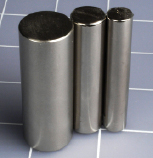
Figure 5-20.
Three neodymium magnets, 1/4-, 1/2-, and 3/4-inch in diameter. I would have preferred to photograph them standing half-an-inch apart, but they refused to permit it.
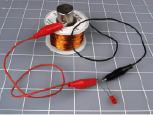
Figure 5-21.
By moving a magnet vigorously up and down through the center of a coil, you generate enough power to make the LED flash brightly.
 Blood Blisters and Dead Media
Blood Blisters and Dead Media
Neodymium magnets can be hazardous. They’re brittle and can shatter if they slam against a piece of magnetic metal (or another magnet). For this reason, many manufacturers advise you to wear eye protection.
Because a magnet pulls with increasing force as the distance between it and another object gets smaller, it closes the final gap very suddenly and powerfully. You can easily pinch your skin and get blood blisters.
If there’s an object made of iron or steel anywhere near a neodymium magnet, the magnet will find it and grab it, with results that may be unpleasant, especially if the object has sharp edges and your hands are in the vicinity. When using a magnet, create a clear area on a nonmagnetic surface, and watch out for magnetic objects underneath the surface. My magnet sensed a steel screw embedded in the underside of a kitchen countertop, and slammed itself into contact with the countertop unexpectedly.
Be aware that magnets create magnets. When a magnetic field passes across an iron or steel object, the object picks up some magnetism of its own. Be careful not to magnetize your watch!
Don’t use magnets anywhere near a computer, a disk drive, credit cards with magnetic stripes, cassettes of any type, and other media. Also keep magnets well away from TV screens and video monitors (especially cathode-ray tubes). Last but not least, powerful magnets can interfere with the normal operation of cardiac pacemakers.
